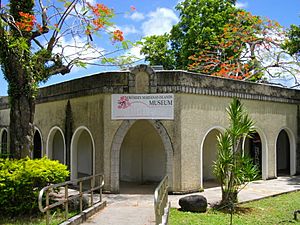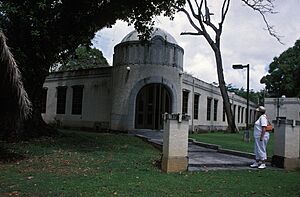NMI Museum of History and Culture facts for kids
| Established | 1998 |
|---|---|
| Location | Kopa Di Oru Street and Chichirica Avenue, Garapan, Saipan |
The NMI Museum of History and Culture, also known as the NMI Museum, is a special place in Garapan, Saipan. It shows amazing exhibits about the Chamorro and Carolinian cultures. You can also see old items, papers, clothes, and photos from different times in the Northern Mariana Islands. These include periods when Spanish, German, Japanese, and American people were present.
The museum has brought back many important historical items to the Marianas. These items were once held by private collectors or museums in other countries. Over a million dollars has been spent to build its collections. The old buildings at the museum have been fixed up. This helps keep them safe and ready for visitors. The museum is right across from Sugar King Park.
The museum offers fun programs for schools. It hosts field trips for students from both local and international schools. It also helps college classes with their studies. People from East Asia, North America, Australia, and other islands in Micronesia visit the museum. It helps with research about land, old businesses, and other historical facts. The museum is the official home for all historical items found during land surveys and digs. It is in charge of keeping these items safe and organized. The museum also lends items to American Memorial Park. It works with other groups for special events.
The museum is run by the Saipan local government. It is listed in the Pacific Islands Museums Association Directory. It is also part of the Garapan Heritage Trail. This project gets help from the Northern Marianas Humanities Council.
Contents
Discovering the Museum's Past
The NMI Museum was created by a law in 1996. It first opened its doors to the public on November 4, 1998.
Early Exhibitions and Gifts
In 1999, the museum showed art by Chen Xiao Ping. In September 1999, it featured an exhibit about Chamorro people who moved to Yap. This exhibit included photos, stories, maps, letters, and church records. In the summer of 1999, the government of Germany gave the museum copies of maps, stamps, and photos. These showed the time when Germany ruled the islands. In November 1999, the museum opened an exhibit called "Tiempon Aleman." This exhibit was about German rule from 1899 to 1914.
In 2000, the museum worked with Japanese groups to create an exhibit. This exhibit was about the Japanese period in the islands. It showed photos, film clips, old items, maps, and postcards. The Sugar King Foundation gave several items, including a special coat. Replicas of old buildings and structures were also made for the exhibit.
War Stories and Important Visitors
In 2004, the museum shared personal stories of Chamorros and Carolinians during the Asia–Pacific War. It also displayed items about the Navajo Code Talkers. Crafts made by civilians in Camp Susupe were also shown. That same year, an exhibit called "The Japanese Administration in the Northern Mariana Islands" opened. It showed items and photos from the sugar industry. In June 2004, the crew of the Enola Gay visited the museum. They donated items to its collection.
In January 2005, Takahisa Aoyagi and Takao Fukushima donated Japanese Period items. These were related to the Nanyoji Temple and the Saipan Girls' High School. That same month, the museum held an exhibit on "The Influence of Catholicism in the Marianas." It displayed old church items like candle holders and bells. In spring 2005, it showed an exhibit about "Castaways on Anatahan." In May 2005, a museum worker found a prehistoric Chamorro fish hook. Students from San Vicente Elementary School visited the museum in May 2005. In July 2005, the mayor of Aizuwakamatsu, Fukushima Prefecture, Japan toured the museum.
In December 2005, students from Tsuru University in Yamanashi Prefecture, Japan visited. In February 2006, the museum's curator gave a talk on prehistoric Chamorro culture. In November 2006, the museum helped host the Shanghai Media Group. In May 2009, a fundraising lunch was held at the museum.
Recent Events and Contributions
In May 2012, the Micronesian Repatriation Association (MRA) of Okinawa gave the museum photos from the Japanese period. In May 2014, the MRA placed a monument on the museum grounds. In June 2014, an "Art in the Park" event was held there.
In October 2014, the museum was part of a walk against domestic violence. In September 2015, volunteers helped clean up after Typhoon Soudelor. In November 2015, the museum sent a worker to an archaeological dig. In 2017, the grandson of Haruji Matsue donated oil paintings of old Saipan. In January 2016, a rain garden was built at the museum. This garden helps catch pollution before it reaches the ocean. In 2016, the museum showed historic handkerchiefs with Japanese pictures. In February 2017, contestants in the Miss Pusong Pinoy pageant visited. In July 2017, the museum took part in the Liberation Day Festival. In December 2017, the museum hosted guests from Japanese companies. In January 2018, the museum gave demonstrations at a tourism summit. This helped students learn about Marianas culture and sustainable tourism.
In the summer of 2019, the museum had an exhibit of old photos. This was for the 75th anniversaries of the Battle of Saipan and Battle of Tinian. In July 2019, the museum helped with Liberation Day. It gave children rides on a carnival train. That same month, the museum held a field trip for a summer reading program. In December 2019, museum staff finished a tour guide training program.
In early January 2020, Saipan International School students visited. Later that month, descendants of Admiral George Anson visited. In late January 2020, the museum took part in a tourism summit for the CNMI Public School System.
Museum Collections
Today, the museum has many interesting collections. These include Micronesian slings, Spanish galleon treasures, and war items. Pottery jars and gold pieces from the sunken ship Nuestra Señora de la Concepción are in the museum's Concepcion Collection. The museum also has a 1934 Latin Mass book and a hundred-year-old chalice. These are on loan from Bishop Ryan Jimenez. The museum keeps items donated by families of American and Japanese veterans. It also has items from Japanese, Okinawan, Korean, Chamorro, and Carolinian people. These people lived in the islands before and during the Pacific War.
The museum plans to build temporary huts for local artists. These huts will be places for artists to teach, show, and sell their products. The museum also wants to build a Chamorro and Carolinian cultural center. This would be like Hawaii's Polynesian Cultural Center.
Museum Buildings
The museum is located in the old Japanese hospital. This building was a medical center on Saipan from 1926 to 1944. It is the largest Japanese building on the island that survived the war. The hospital was added to the National Register of Historic Places in 1974.
In 2019, the Japanese laboratory next to the hospital was fixed up. This building might become the museum's gift and coffee shop. This change would help the museum earn money.
Supporting the Museum
The museum has sometimes faced challenges with funding. In the 2000s and 2010s, its budget and staff were cut. Staff members sometimes paid for light bulbs, lawn tools, computers, and fuel themselves. They also volunteered their time to keep the museum open for tours and events.
Some museum property was damaged because of a lack of money for repairs. Tropical storms also caused damage. In 2000, floods caused minor damage to items. In October 2008, heavy rain flooded the museum. This brought water and mud into the exhibit areas. In 2015, Typhoon Soudelor damaged the museum and trees. There was water damage, and plants grew in cracks of the building. Damaged items included an old Chamorro canoe and Japanese military uniforms.
In May 2014, money from a lawsuit against the Saipan garment industry was given to the museum. In March 2019, the museum partnered with Saipan Southern High School for a carwash fundraiser.
Museum Helpers
The museum director once told the Saipan Tribune that they want to help keep the CNMI culture alive. They also want to promote it as a tourist spot. He said that supporters are "investing in the future of the children of the CNMI."
In 2004, Pacific Development Inc. on Saipan gave money to the museum. The museum has limited space for storing items and for staff to work. In 2017, the United States Department of Defense, Saipan Shipping Company, and IT&E donated three large containers. These were changed to hold human remains and artifacts.
In 2017, IT&E provided three small air-conditioning units for the museum. In the late 2010s, the museum received grants from the Marianas Visitors Authority. These grants helped preserve the building and protect its exhibits. IT&E Saipan also provided phone and internet services.
In June 2018, McDonald's Saipan gave the museum $3,000. In July 2018, the Marianas Young Professionals raised over $2,000. This included a $1,000 donation from Duty Free Saipan (DFS) Ltd. In 2020, the Tan Siu Lin Foundation also donated to the museum.



